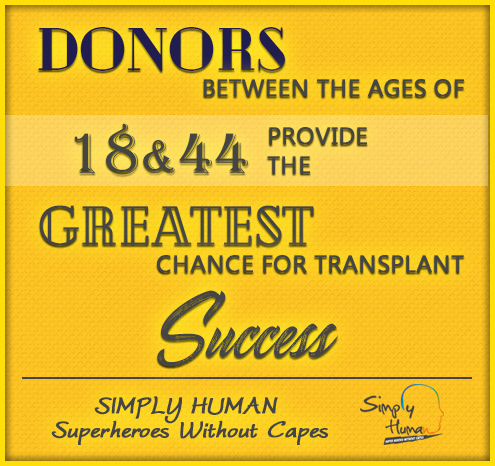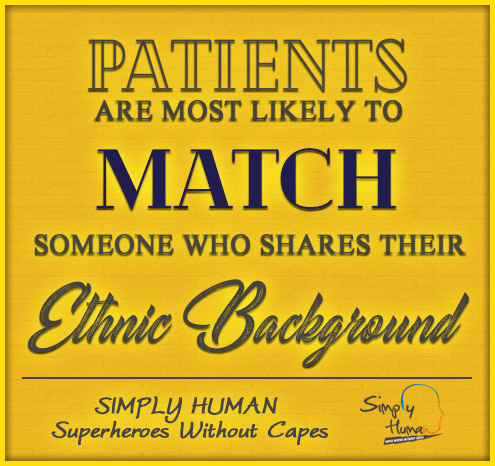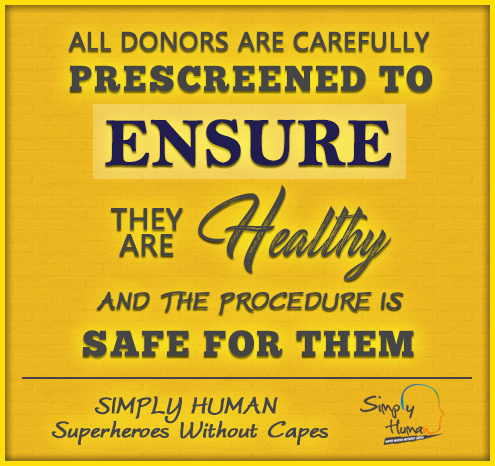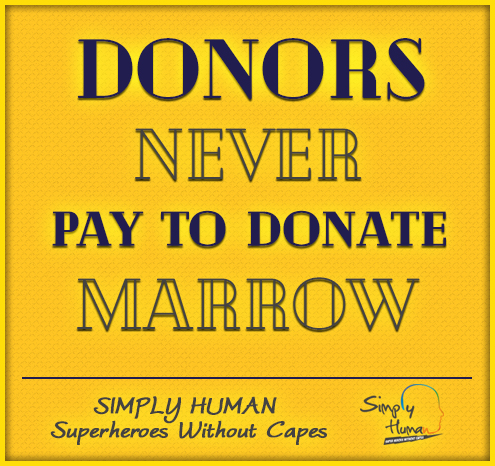Donors between the ages of 18 & 44 provide the greatest chance for transplant success.

Doctors request donors in the 18-44 age group more than 95% of the time.
Age guidelines are not meant to discriminate. They are meant to protect the safety of the donor and provide the best possible outcome for the patient.
Patients are most likely to match someone of the same ancestry.

Adding more members who increase the ethnic diversity of the registry increases the variety of tissue types available, helping more patients find the match they need. We especially need members who identify as:
Members with these backgrounds are especially needed:
- Black or African American
- American Indian or Alaska Native
- Asian, including South Asian
- Native Hawaiian or other Pacific Islander
- Hispanic or Latino
- Multiracial
All donors are carefully pre-screened to ensure they are healthy and the procedure is safe for them.

There are two methods of donation: peripheral blood stem cells (PBSC) and bone marrow. The patient’s doctor chooses the donation method that is best for the patient.
- PBSC donation is a nonsurgical procedure and the most common way to donate. For 5 days leading up to donation, you will be given injections of a drug to increase the number of cells in your bloodstream that are used for transplant. Some of your blood is then removed through a needle in one arm and passed through a machine that separates out the blood-forming cells. The remaining blood is returned to you through the other arm.
- Bone marrow donation is a surgical, usually outpatient procedure. You will receive anesthesia and feel no pain during the donation. Doctors use a needle to withdraw liquid marrow from the back of your pelvic bone. To learn more, watch the marrow donation video.
Though no medical procedure is without risk, there are rarely any long-term side effects donating either PBSC or bone marrow. Your cells replenish themselves in 4 to 6 weeks.
Because only 1 to 5% or less of your marrow is needed to save the patient’s life, your immune system stays strong.
Donors never pay to donate marrow.

Your Super Power saves lives. Simply Human relies on financial contributions.

Simply Human Inc. relies on financial contributions to:
- Grow the Australian Bone Marrow Donor Registry (ABMDR) of potential marrow donors
- Help cancer fighters with crippling transplant costs
- Educate people about Cancer/Leukaemia and Bone Marrow Transplant process.
- Advance the science of transplant
There are many ways you can help even if donation is not an option:
- Fundraise
- Host a drive-in collaboration with us
- Become a Volunteer – Share your Super Power
- Spread the word – Like & Share our Page on Social Media Platforms
Diseases treatable by transplant
A bone marrow or cord blood transplant may be the best treatment option or the only potential for a cure for patients with leukemia, lymphoma, sickle cell anemia and many other diseases. As the science of transplant continues to advance, new diseases are being treated with transplant.
Leukemias and lymphomas, including:
- Acute myelogeneous leukemia (AML)—The most common type of acute leukemia with nearly 15,000 new cases found in the United States each year. AML can affect people of any age, but is most common in adults.
- Acute lymphoblastic leukemia(ALL)—There are about 6,000 new cases of ALL in the United States each year. It can affect people of any age, but is the most common type of leukemia in children under 15.
- Chronic lymphocytic leukemia(CLL)—Primarily an adult disease, CLL is very rare in children and young adults. About 15,000 people are diagnosed each year in the United States.
- Chronic myelogeneous leukemia(CML)—A relatively common form of leukemia, it affects more than 20,000 people in the United States with 6,000 new cases each year. Most cases of CML appear in adults.
- Juvenile myelomonocytic leukemia
- Hodgkin lymphoma
- Non-Hodgkin lymphoma(NHL)—Each year about 69,000 people are diagnosed with NHL in the United States. Most of these people are older than 60.
Bone marrow diseases and other diseases when bone marrow fails to work, including:
- Severe aplastic anemia—A rare disease with 600-900 people diagnosed each year. The disease appears more often in eastern Asian countries. It can affect people of any age, but is most common in young adults.
- Fanconianemia
- Paroxysmal nocturnal hemoglobinuria (PNH)
- Pure red cell aplasia
- Amegakaryocytosis/congenital thrombocytopenia
Inherited immune system disorders, including:
- Severe combined immunodeficiency(SCID, all types)—SCID is a group of inherited immune system disorders that are present at birth. They can become life-threatening within the first year of life if left untreated. In the United States, about 1 in 100,000 babies are born with SCID.
- Wiskott-Aldrich syndrome(WAS)—WAS is an inherited immune system disorder that is present at birth. It affects mostly boys. In the U.S. about 1 in 100,000 boys are born with it.
Hemoglobinopathies (diseases with poorly functioning red blood cells), including:
- Beta thalassemia major
- Sickle cell disease(SCD)—Sickle cell disease is an inherited disease of the red blood cells. In the United States, it affects about 70,000-100,000 people and is most common among African Americans and Hispanics
Inherited metabolic disorders, including:
- Krabbe disease (GLD)—GLD is very rare. Only about 40 children are diagnosed in the United States each year. Most often it appears in the first months of life (early-onset). There is also another form of the disease that doesn’t show until later in childhood or even into teenage years (late-onset).
- Hurler syndrome(MPS-IH)—Occurs in about 1 of every 100,000 babies born. If not treated, children born with this disease usually die by 5 to 10 years of age.
- Adrenoleukodystrophy(ALD)—Both boys and girls can be born with ALD, but boys are more likely to have symptoms. One out of 3 boys born with ALD has the most severe form of it, cerebral X-linked ALD. The form is rare, affecting about 1 in 20,000 individuals worldwide.
- Metachromatic leukodystrophy(MLD)—MLD appears most often in babies and young toddlers, but it also occurs in older children and adults. MLD is rare. It occurs in about 1 in 40,000 to 160,000 individuals worldwide.
Myelodysplastic syndromesand myeloproliferative disorders. MDS are a group of diseases that affect the bone marrow and blood. About 19,000 people are diagnosed with MDS in the United States each year.
Multiple myeloma and other plasma cell disorders
Familial erythrophagocyticlymphohistiocytosis and other histiocytic disorders
Certain other malignancies or cancers
Replacing diseased cells with healthy ones
These cells can come from three sources:
- Bone marrow
- Peripheral (circulating) blood (also called peripheral blood stem cells or PBSC)
- Blood collected from an umbilical cord after a baby is born
Doctors will choose the best source of cells for a patient.
What is a Stem Cell Transplant (Bone Marrow Transplant)?
A stem cell transplant is a treatment for some types of cancer. For example, you might have one if you have leukemia, multiple myeloma, or some types of lymphoma. Doctors also treat some blood diseases with stem cell transplants.
In the past, patients who needed a stem cell transplant received a “bone marrow transplant” because the stem cells were collected from the bone marrow. Today, stem cells are usually collected from the blood, instead of the bone marrow. For this reason, they are now more commonly called stem cell transplants.
Why are bone marrow and stem cells important?
A part of your bones called “bone marrow” makes blood cells. Marrow is the soft, spongy tissue inside bones. It contains cells called “hematopoietic” stem cells. These cells can turn into several other types of cells. They can turn into more bone marrow cells. Or they can turn into any type of blood cell.
Certain cancers and other diseases keep hematopoietic stem cells from developing normally. If they are not normal, neither are the blood cells that they make. A stem cell transplant gives you new stem cells. The new stem cells can make new, healthy blood cells.
Types of stem cell transplant
The main types of stem cell transplants and other options are discussed below.
- Autologous transplant. Doctors call this an AUTO transplant. This type of stem cell transplant may also be called high-dose chemotherapy with autologous stem cell rescue.
In an AUTO transplant, you get your own stem cells after doctors treat the cancer. First, your health care team collects stem cells from your blood and freezes them. Next, you have powerful chemotherapy, and rarely, radiation therapy. Then, your health care team thaws your frozen stem cells. They put them back in your blood through a tube placed in a vein (IV).
It takes about 24 hours for your stem cells to reach the bone marrow. Then they start to grow, multiply, and help the marrow make healthy blood cells again. - Allogeneic transplantation. Doctors call this an ALLO transplant.
In an ALLO transplant, you get another person’s stem cells. It is important to find someone whose bone marrow matches yours. This is because you have certain proteins on your white blood cells called human leukocyte antigens (HLA). The best donor has HLA proteins as much like yours as possible.
Matching proteins make a serious condition called graft-versus-host disease (GVHD) less likely. In GVHD, healthy cells from the transplant attack your cells. A brother or sister may be the best match. But another family member or volunteer might work.
Once you find a donor, you receive chemotherapy with or without radiation therapy. Next, you get the other person’s stem cells through a tube placed in a vein (IV). The cells in an ALLO transplant are not typically frozen. So, doctors can give you the cells as soon after chemotherapy or radiation therapy as possible.
There are 2 types of ALLO transplants. The best type for each patient depends his or her age and health and the type of disease being treated.
- Ablative, which uses high-dose chemotherapy
- Reduced intensity, which uses milder doses of chemotherapy
If your health care team cannot find a matched adult donor, there are other options. Research is ongoing to determine which type of transplant will work best for different patients.
- Umbilical cord blood transplant. This may be an option if you cannot find a donor match. Cancer centers around the world use cord blood.
- Parent-child transplant and haplotype mismatched transplant. These types of transplants are being used more commonly. The match is 50%, instead of near 100%. Your donor might be a parent, child, brother, or sister.
Choosing a transplant
Your doctor will recommend an AUTO or ALLO transplant based mostly on the disease you have. Other factors include the health of your bone marrow and your age and general health. For example, if you have cancer or other disease in your bone marrow, you will probably have an ALLO transplant. In this situation, doctors do not recommend using your own stem cells.
Choosing a transplant is complicated. You will need help from a doctor who specializes in transplants. So you might need to travel to a center that does many stem cell transplants. Your donor might need to go, too. At the center, you talk with a transplant specialist and have an examination and tests. Before a transplant, you should also think about non-medical factors. These include:
- Who can care for you during treatment
- How long you will be away from work and family responsibilities
- If your insurance pays for the transplant
- Who can take you to transplant appointments
Your health care team can help you find answers to these questions.
How a transplant works
The information below tells you the main parts of AUTO and ALLO transplants. Your health care team usually does the steps in order. But sometimes certain steps happen in advance, such as collecting stem cells. Ask your doctor what to expect before, during, and after a transplant.
AUTO transplant timeline
Part 1: Collecting your stem cells
- A doctor puts a thin tube called a “transplant catheter” in a large vein. The tube stays in until after the transplant. Your health care team will collect stem cells through this tube and give chemotherapy and other medications through the tube.
- You get injections of a medication to raise your number of white blood cells. White blood cells help your body fight infections.
- Your health care team collects stem cells, usually from your blood.
Time: 1 to 2 weeks
Where it’s done: Clinic or hospital building. You do not need to stay in the hospital overnight.
Part 2: Transplant treatment
- You get high doses of chemotherapy, and rarely, radiation therapy.
Time: 5 to 10 days
Where it’s done: Clinic or hospital. At many transplant centers, patients need to stay in the hospital for the duration of the transplant, usually about 3 weeks. At some centers, patients receive treatment in the clinic and can come in every day.
Part 3: Getting your stem cells back
- Doctors call this the “stem cell transfusion.” Your health care team puts your stem cells back in your blood through the transplant catheter.
Time: Each infusion usually takes less than 30 minutes. You may receive more than 1 infusion.
Where it’s done: Clinic or hospital.
Part 4: Recovery
- You take antibiotics and other drugs. You get blood transfusions through your transplant catheter if needed. Your health care team helps with any transplant side effects.
Time: approximately 2 weeks
Where it’s done: Clinic or hospital. You might be staying in the hospital or you might not.
ALLO transplant timeline
Part 1: Collecting stem cells from your donor
- The health care team gives your donor injections of a medication to increase white cells in the blood, if the cells are collected from blood. Some donors will donate bone marrow in the operating room during a procedure which takes several hours.
Time: Varies based on how the stem cells are collected
Where it’s done: Clinic or hospital
Part 2: Transplant treatment
- You get chemotherapy with or without radiation.
Time: 5 to 7 days
Where it’s done: Many ALLO transplants are done in the hospital.
Part 3: Getting the donor cells
- Doctors call this the “stem cell transfusion.” Your health care team puts the donor’s stem cells in your blood through the transplant catheter. It takes less than 1 hour. The transplant catheter stays in until after treatment.
Time: 1 day
Where it’s done: Clinic or hospital.
Part 4: Recovery
- You take antibiotics and other drugs. This includes medications to prevent graft-versus-host disease. You get blood transfusions through your catheter if needed. Your health care team takes care of any side effects from the transplant.
- After the transplant, patients visit the clinic frequently at first and less often over time.
Time: Varies
- For an ablative transplant, patients are usually in the hospital for about 4 weeks in total.
- For a reduced intensity transplant, patients are in the hospital or visit the clinic daily for about 1 week.
Milestones of successful transplant
The words “successful transplant” might mean different things to you, your family, and your doctor. Below are 2 ways to measure transplant success.
Your blood counts are back to safe levels. A “blood count” is the number of red cells, white cells, and platelets in your blood. A transplant makes these numbers very low for 1 to 2 weeks. This causes risks of:
- Infection from low numbers of white cells, which fight infections
- Bleeding from low numbers of platelets, which stop bleeding
- Tiredness from low numbers of red cells, which carry oxygen
Doctors lower these risks by giving blood and platelet transfusions after a transplant. You also take antibiotics to help prevent infections. When the new stem cells multiply, they make more blood cells. Then your blood counts improve. This is one way to know if a transplant is a success.
It controls your cancer. Doctors do stem cell transplants with the goal of curing disease. A cure may be possible for some cancers, such as some types of leukemia and lymphoma. For other patients, remission is the best result. Remission is having no signs or symptoms of cancer. After a transplant, you need to see your doctor and have tests to watch for any signs of cancer or complications from the transplant.
Questions to ask the doctor
Talking often with the doctor is important. It gives you information to make health care decisions. The questions below may help you learn more about stem cell transplant. You can also ask other questions that are important to you.
- Which type of stem cell transplant would you recommend? Why?
- If I will have an ALLO transplant, how will we find a donor? What is the chance of a good match?
- What type of treatment will I have before the transplant? Will radiation therapy be used?
- How long will my treatment take? How long will I stay in the hospital?
- How will a transplant affect my life? Can I work? Can I exercise and do regular activities?
- How will we know if the transplant works?
- What if the transplant doesn’t work? What if the cancer comes back?
- What are the side effects? This includes short-term, such as during treatment and shortly after. It also includes long-term, such as years later.
- What tests will I need later? How often will I need them?
- If I am worried about managing the costs of treatment, who can help me with these concerns?
Source – Approved by the Cancer.Net Editorial Board, 01/2016
Three Different Types of Transplants
Allogeneic (Donor) Transplants
What is an allogeneic transplant?
In an allogeneic transplant, stem cells are donated to the person from another person, a genetically matched stem cell donor. This is usually a family member, a brother or sister with the same tissue type. Where no sibling is available, a search is made of Australian and overseas donor registries to find a suitably matched, unrelated stem cell donor. Sometimes there is a slight mismatch between the tissue type of the donor (usually a family member) and the person, but they may still be the best possible match.
In an allogeneic transplant the donor’s healthy stem cells are used to replace the person’s unhealthy ones, which have been damaged by disease, by giving high doses of chemotherapy and radiotherapy used to treat the underlying disease. The cells of the donor’s immune system (white blood cells) are transplanted along with the donor’s stem cells. It is hoped that these cells will also attack and destroy all traces of the underlying disease.
When is it used?
An allogeneic transplant offers the best chance of curing a number of blood cancers and other serious diseases. These include: leukaemia, some types of lymphoma, myeloma, myelodysplastic syndromes, aplastic anaemia and other rare bone marrow diseases. These are however complex procedures that carry significant risks.
The complexities and risks increase even more when the donor is unrelated, or when there is a slight mismatch between the donor and recipient tissue type. As such, allogeneic transplants are usually not suitable for people over the age of 60 years, or for people with certain types of health problems.
A ‘mini-allogeneic’, ‘reduced intensity’ transplant uses less intensive and therefore less toxic chemotherapy. This is also called a nonmyeloablative transplant’, because the treatment used doesn’t completely destroy your bone marrow. This may be an option for older people and others who could benefit from receiving donated stem cells but for whom a standard allogeneic transplant would be considered too risky. Using this approach, it is hoped that the donor’s immune system will attack and destroy cancer cells in your body. Meanwhile, the chemotherapy helps to treat the underlying disease and suppress your immune system, reducing the risk of rejection.
How are the stem cells collected?
The donor has to undergo a series of injections called Granulocyte Colony Stimulating Factor (G-CSF) (usually four doses given over four days) to stimulate the stem cells to enter the blood stream. Once the Peripheral Blood Stem Cells (PBSC) are at a certain level in the blood stream, the donor is attached to a blood cell separator (apheresis machine) where the cells are withdrawn from the blood of the donor.
During the procedure, the donor relaxes in a chair or bed and can often read a book or watch TV. The procedure is painless and when it is over the donor may feel slightly tried but can resume normal activities.
The transplant
In the week leading up to your transplant, you are given a few days of very high doses of chemotherapy, and sometimes radiotherapy, to destroy your underlying disease, and suppress your immune system so that it will accept the donor stem cells. This is called conditioning therapy. After you have finished this part of your treatment, the donated stem cells are infused through a vein into your blood stream. This is similar to a blood transfusion. From here the stem cells make their way to your bone marrow where they become established and start making new blood cells.
Your blood counts drop dramatically in the week following conditioning therapy. This is normal. During this time you will be more at risk of infections (due to the lack of infection-fighting white blood cells) and bleeding (due to a lack of platelets).
Antibiotics and other drugs are commonly prescribed to help prevent or treat infections during this time, and you are likely to need platelet transfusions to reduce the risk of bleeding. Red blood cell transfusions are given when haemoglobin levels are too low. During this time you are likely to be experiencing some of the common side effects of chemotherapy, and radiotherapy including nausea and vomiting, mucositis (sore mouth) and bowel problems (diarrhoea).
Once the blood counts start to rise and you are otherwise well enough, you are usually allowed to leave the hospital. In the early weeks and months after your transplant you will need to come in to the hospital or clinic regularly so that the doctor can check your blood counts, see how you are progressing and deal with any problems that may arise.
What are the side effects of an allogeneic transplant?
Most of the side effects of an allogeneic transplant are caused by the conditioning therapy used. While many of these side-effects last for a short time, some can last longer. Some side-effects persist for months and occasionally years after the transplant.
Graft-versus-host disease
The donor’s stem cells can cause a common, sometimes serious complication of allogeneic transplants called graft-versus-host-disease (GVHD). This is an immune reaction whereby cells from the donor’s immune system recognise the patient’s body as foreign and attack it. GVHD can vary in severity and the extent to which it causes problems in the body.
When it develops soon after the transplant it is called acute GVHD. This is usually managed with drugs, including steroids to further suppress the new immune system and reduce the symptoms. It can also develop at a later stage, or persist for months and sometimes years after the transplant. If you are having an allogeneic transplant you will be given special drugs called immunosuppressants (anti-rejection drugs) before, during and for some time after the transplant. They also help to suppress the ‘new’ (donor’s) immune system to reduce GVHD and prevent it from causing serious problems in the body.
These drugs also help to reduce the risk of the donor’s stem cells being rejected by your body.
It can take a year or even longer for the immune system to fully recover following an allogeneic transplant. As such there is a risk of infection for some time after your transplant. It is important to take some sensible precautions to prevent infections during this time (for example avoid contact with people with an illness like flu or chicken pox).
High dose treatment can cause fertility problems, affecting your ability to have a baby in the future. In women these treatments can also cause an earlier than expected onset of menopause (change of life), even at a young age.
Your doctor will discuss with you all the expected side-effects of your treatment, and the steps that can be taken to help reduce or prevent them.
Does it work?
The success of your transplant will depend on a number of factors including the type and stage of disease you have, your age and your general health.
Important advances have been made in recent years, and continue to be made, improving the success of all types of transplants. Despite this, allogeneic transplants are still associated with serious and sometimes life threatening complications. Unfortunately, a small number of people will not survive the transplant process. Your doctor will spend time discussing with you and your family the risks and benefits of an allogeneic transplant.
It generally takes 12 months or longer to recover after an allogeneic transplant. During this time, it is important to look after yourself and to try to focus on the things you can do to help yourself recover well both physically and emotionally.
For more information, contact us via email, meet us in person or attend one of our informative session.
Autologous (Self) Transplants
What is an autologous transplant?
An autologous transplant (or rescue) is a type of transplant that uses the person’s own stem cells. These cells are collected in advance and returned at a later stage. They are used to replace stem cells that have been damaged by high doses of chemotherapy, used to treat the person’s underlying disease.
When is it used?
Autologous transplants are used to treat a number of different blood cancers – leukaemias lymphomas and myeloma, and certain solid tumours – breast cancer, testicular cancer, osteosarcoma and others. Autologous transplants allow the use of high dose chemotherapy, which provides some people with a better chance of cure or long-term control of their disease.
Most people have a single autologous transplant. Others, particularly those with myeloma or some solid tumours, may have two or more sequential (one after the other) transplants, over a period of a few months.
How are the stem cells collected?
In most cases, stem cells are collected directly from the bloodstream. While stem cells normally live in your marrow, a combination of chemotherapy and a growth factor (a drug that stimulates stem cells) called Granulocyte Colony Stimulating Factor (G-CSF) is used to expand the number of stem cells in the marrow and cause them to spill out into the circulating blood. From here they can be collected from a vein by passing the blood through a special machine called a cell separator, in a process similar to dialysis. This machine separates and collects the stem cells and returns the rest of your blood to you. The stem cells are then processed, frozen and stored until the scheduled date of your transplant. This procedure is usually carried out in the outpatient department of the hospital.
The transplant
In the week leading up to your transplant you will be given a few days of very high dose chemotherapy, and sometimes radiotherapy, to destroy your underlying disease. This is called conditioning therapy. After you have finished this treatment, your stem cells are thawed and reinfused through a vein into your blood stream. This is similar to a blood transfusion. From here, the stem cells make their way to your bone marrow where they become re-established and start making new blood cells.
After the transplant
Your blood counts drop dramatically in the week following your conditioning therapy. This is normal. During this time you will be more at risk of infections (due to the lack of infection-fighting white blood cells) and bleeding (due to a lack of platelets). Antibiotics and other drugs are commonly prescribed to help prevent or treat infections during this time, and you are likely to need platelet transfusions to reduce your risk of bleeding. Red blood cell transfusions are given when your haemoglobin levels are too low. During this time you are likely to be experiencing some of the common side effects of chemotherapy and radiotherapy, including nausea and vomiting, mucositis (sore mouth) and bowel problems (diarrhoea).
Once your blood counts start to rise and you are otherwise well enough, you are usually allowed to leave the hospital. In the early weeks after your transplant, you will need to come in to the hospital or clinic regularly so that the doctor can check your blood counts and see how you are progressing.
It can take a few months for your immune system to recover after an autologous transplant so it is important to take some sensible precautions to prevent infections during this time (for example avoid contact with people with an illness like flu or chicken pox).
What are the side effects of an autologous transplant?
Most of the side effects of an autologous transplant are caused by the conditioning therapy used. Although they can be very unpleasant at times it is important to remember that most of them are temporary and reversible.
Conditioning therapies also cause some long-term side-effects. For example high dose treatments can cause fertility problems, affecting your ability to have a baby in the future. In women these treatment’s can also cause an earlier than expected onset of menopause (change of life), even at a young age.
Your doctor will discuss with you all the expected side-effects of your treatment, and the steps that can be taken to help reduce or prevent them.
Does it work?
The success of your transplant will depend on a number of factors including the type and stage of disease you have, your age and your general health.
Important advances have been made in recent years, and continue to be made, improving the success of all types of transplants. Despite this, many people experience a relapse of their original disease at some stage following an autologous transplant. If your disease relapses, there are often ways of getting it back under control. These may include more chemotherapy and/or another transplant, or a drug to stimulate your immune system to fight the disease. Your doctor will advise you on your chances of relapse following an autologous transplant.
It generally takes between three and six months to recover fully after an autologous transplant. During this time it is important to look after yourself and to try to focus on the things you can do to help yourself recover well both physically and emotionally.
For more information, contact us via email, meet us in person or attend one of our informative session.
Haploidentical Stem Cell Transplant
An allogeneic haemopoietic stem cell (HPC) transplant involves matching a patient’s tissue type, specifically their human leukocyte antigen (HLA) tissue type, with that of a related or unrelated donor. HLA proteins are found on all cells of our body and are the main way the immune system tells the difference between our own cells and foreign cells.
The closer the HLA match between a donor and recipient, the greater the chance a transplant will be successful.
If the HLA match is not close enough, the donor’s immune system, which accompanies the donated stem cells, recognises the HLA mismatch, and will attack the recipient’s tissues. This process is known as graft versus host disease (GVHD).
Approximately 70% of people with a haematological malignancy or bone marrow failure syndrome who need an allogeneic transplant have a HLA-identical sibling or unrelated donor available.
For patients who need a stem cell transplant but do not have a HLA-matched related or unrelated donor, recent medical advances have made possible the use of a partially matched or haploidentical related donor. A haploidentical related donor is usually a 50% match to the recipient and may be the recipient’s parent, sibling or child.
The advantage of having a haploidentical transplant is that it increases the chance of finding a donor as almost everyone has at least one haploidentical relative. Relatives can usually be asked to donate stem cells much more quickly than unrelated volunteer donors, particularly when the volunteer donors live in other countries, thereby allowing transplants to be done in a more timely way.
With improvements in medical treatment, complications of a haploidentical transplant, such as GVHD, rejection of the graft and slow recovery of the immune system appear not to be increased compared to transplants using HLA matched related or unrelated donors.
Since this is a relatively new approach to stem cell transplantation, a haploidentical transplant is a treatment option that is not offered in all treatment centres.
For more information, contact us via email, meet us in person or attend one of our informative session.
